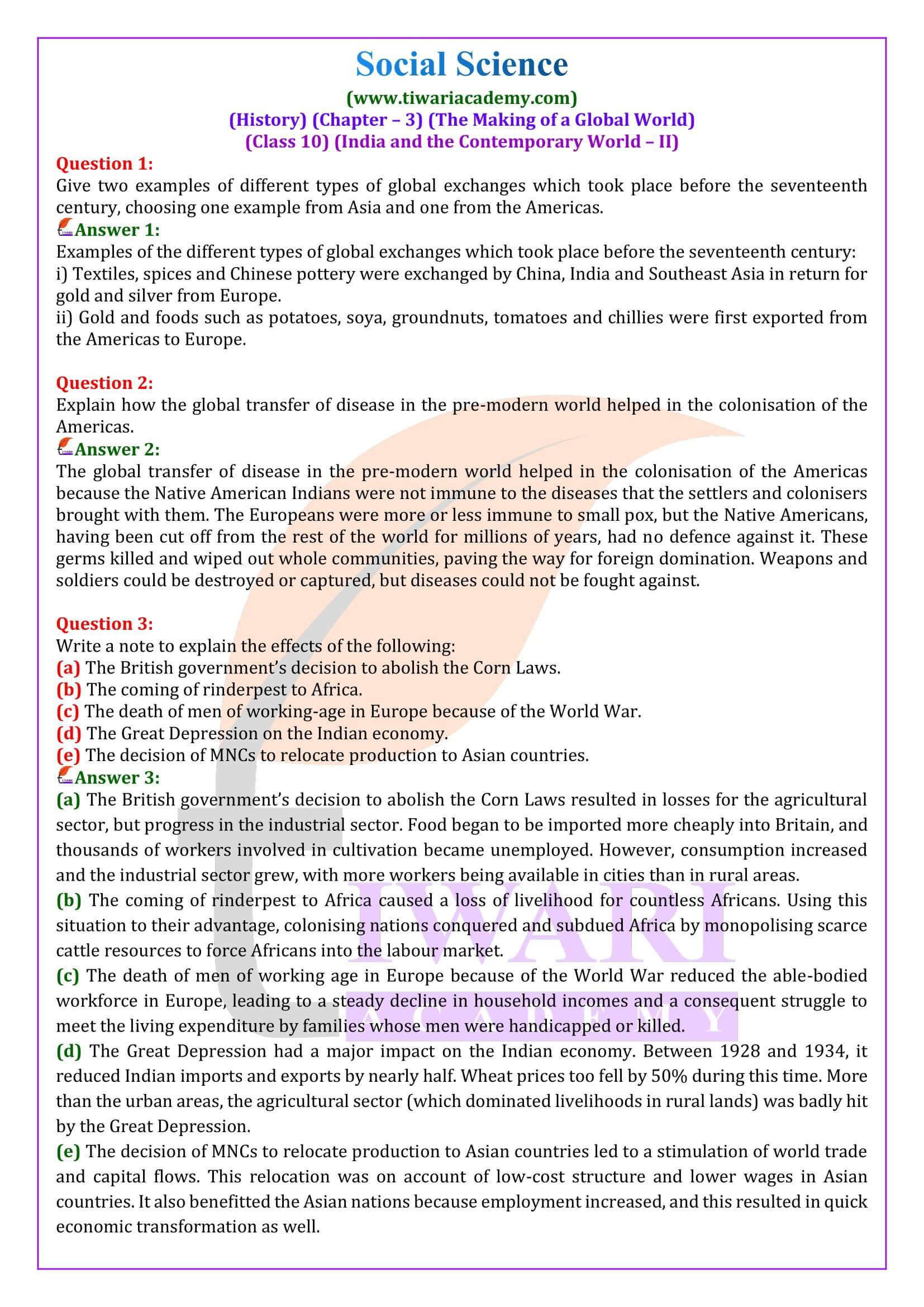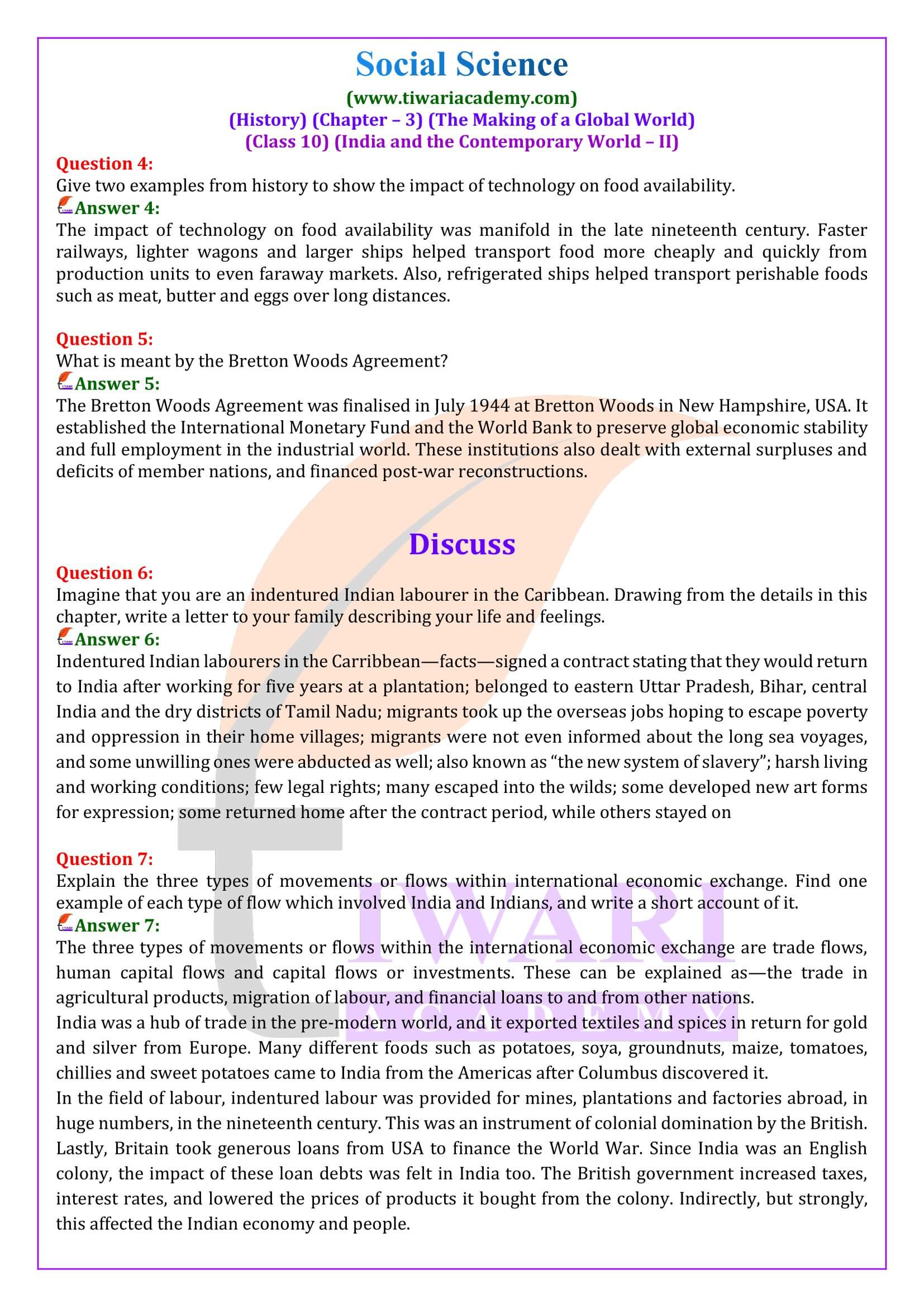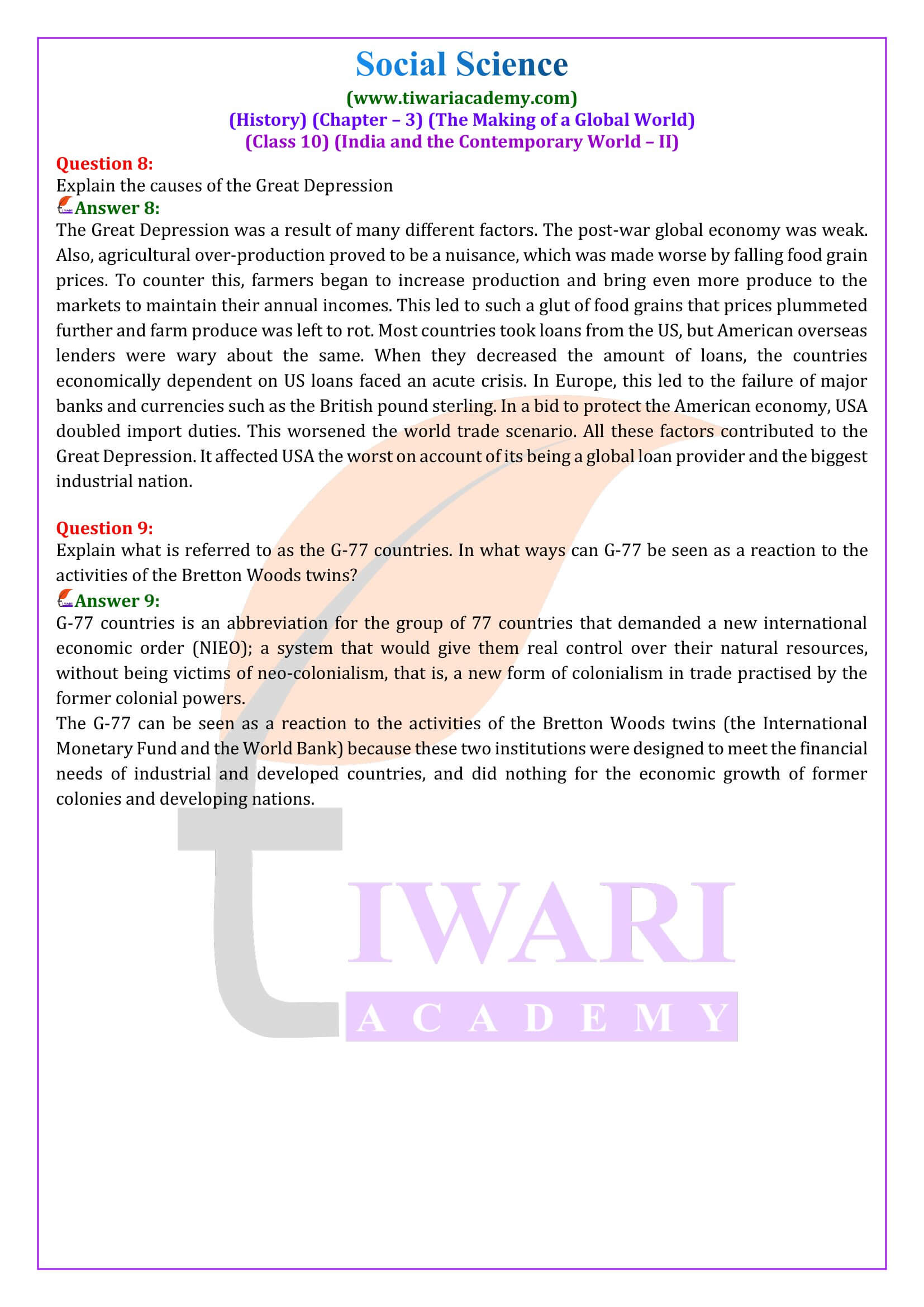NCERT Solutions for Class 10 History Chapter 3 The Making of a Global World in Hindi and English Medium along with updated study material and revision books for new academic session 2025-26. Download the solutions of other subjects of class 10 from NCERT Solutions main page. All the solutions are updated for new academic session 2025-26 for CBSE, MP Board, Gujrat Board, etc., who are using NCERT Textbooks as course books.
NCERT Solutions for Class 10 History Chapter 3
NCERT Solutions for Class 10 History Chapter 3
| Class: | 10 |
| Subject: | Social Science – History |
| Chapter 3: | The Making of a Global World |
| Academic Session: | 2025-26 |
Class 10 History Chapter 3 The Making of a Global World
NCERT Solutions for Class 10 History Chapter 3 in PDF form free to download is given below. Download Offline Apps based on new NCERT Books and following current CBSE Syllabus.
Exatra Questions Class 10 History Chapter 3
What is Silk routes?
The ‘silk routes’ points to the importance of West-bound Chinese silk cargoes along this route. Historians have identified several silk routes, over land and by sea, knitting together vast regions of Asia, and linking Asia with Europe and northern Africa.
What do you understand by Corn law?
Under pressure from landed groups, the British government restricted the import of corn. The laws allowing the government to do this were commonly known as the ‘Corn Laws’.
What does Bretton Woods refer?
Bretton Woods is the name of Hotel in USA where the National Monetary and Financial conference held in 1944 to ensure the stable economy.
What is meant by Hosay?
Trinidad the annual Muharram procession was transformed into a riotous carnival called `Hosay’ (for Imam Hussain) in which workers of all races and religions joined.
Explain G-77 in brief.
G-77 was a group organized by developing countries to demand a New International Economical Order (NIEO) which would give these countries real control over their national resources, raw material,
manufactured goods and their markets.
What is Tariff?
Tax imposed on a country’s imports from the rest of the world. Tariffs are levied at the point of entry, i.e., at the border or the airport.
Define Exchange Rates?
They link national currencies for purposes of international trade. There are broadly two kinds of exchange rates: fixed exchange rate and floating exchange rate
One Mark Questions with Answers
1) Name the Allied Countries?
2) Which country has the veto power in IMF and world bank?
3) Name those two inventions of nineteenth century which brought changes in the world?
4) Who discovered American continent?
5) Name the European country which conquered America?
Answers of 1 Mark Questions
1) Britain, France and Russia.
2) United States of America
3) 1) Steam engine 2) Railways
4) Christopher Columbus.
5) Spain
Important Questions on Class 10 History Chapter 3
Give two examples of different types of global exchanges which took place before the seventeenth century, choosing one example from Asia and one from the Americas.
Examples of the different types of global exchanges which took place before the seventeenth century: i) Textiles, spices and Chinese pottery were exchanged by China, India and Southeast Asia in return for gold and silver from Europe. ii) Gold and foods such as potatoes, soya, groundnuts, tomatoes and chillies were first exported from the Americas to Europe.
Explain how the global transfer of disease in the pre-modern world helped in the colonisation of the Americas.
The global transfer of disease in the pre-modern world helped in the colonisation of the Americas because the Native American Indians were not immune to the diseases that the settlers and colonisers brought with them. The Europeans were more or less immune to small pox, but the Native Americans, having been cut off from the rest of the world for millions of years, had no defence against it. These germs killed and wiped out whole communities, paving the way for foreign domination. Weapons and soldiers could be destroyed or captured, but diseases could not be fought against.
Give two examples from history to show the impact of technology on food availability.
The impact of technology on food availability was manifold in the late nineteenth century. Faster railways, lighter wagons and larger ships helped transport food more cheaply and quickly from production units to even faraway markets. Also, refrigerated ships helped transport perishable foods such as meat, butter and eggs over long distances.
What is meant by the Bretton Woods Agreement?
The Bretton Woods Agreement was finalised in July 1944 at Bretton Woods in New Hampshire, USA. It established the International Monetary Fund and the World Bank to preserve global economic stability and full employment in the industrial world. These institutions also dealt with external surpluses and deficits of member nations, and financed post-war reconstructions.
Imagine that you are an indentured Indian labourer in the Caribbean. Drawing from the details in this chapter, write a letter to your family describing your life and feelings.
Indentured Indian labourers in the Carribbean—facts—signed a contract stating that they would return to India after working for five years at a plantation; belonged to eastern Uttar Pradesh, Bihar, central India and the dry districts of Tamil Nadu; migrants took up the overseas jobs hoping to escape poverty and oppression in their home villages; migrants were not even informed about the long sea voyages, and some unwilling ones were abducted as well; also known as “the new system of slavery”; harsh living and working conditions; few legal rights; many escaped into the wilds; some developed new art forms for expression; some returned home after the contract period, while others stayed on.
Explain the three types of movements or flows within international economic exchange. Find one example of each type of flow which involved India and Indians, and write a short account of it.
The three types of movements or flows within the international economic exchange are trade flows, human capital flows and capital flows or investments. These can be explained as—the trade in agricultural products, migration of labour, and financial loans to and from other nations. India was a hub of trade in the pre-modern world, and it exported textiles and spices in return for gold and silver from Europe. Many different foods such as potatoes, soya, groundnuts, maize, tomatoes, chillies and sweet potatoes came to India from the Americas after Columbus discovered it. In the field of labour, indentured labour was provided for mines, plantations and factories abroad, in huge numbers, in the nineteenth century. This was an instrument of colonial domination by the British. Lastly, Britain took generous loans from USA to finance the World War. Since India was an English colony, the impact of these loan debts was felt in India too. The British government increased taxes, interest rates, and lowered the prices of products it bought from the colony. Indirectly, but strongly, this affected the Indian economy and people.
Explain the causes of the Great Depression.
The Great Depression was a result of many different factors. The post-war global economy was weak. Also, agricultural over-production proved to be a nuisance, which was made worse by falling food grain prices. To counter this, farmers began to increase production and bring even more produce to the markets to maintain their annual incomes. This led to such a glut of food grains that prices plummeted further and farm produce was left to rot. Most countries took loans from the US, but American overseas lenders were wary about the same. When they decreased the amount of loans, the countries economically dependent on US loans faced an acute crisis. In Europe, this led to the failure of major banks and currencies such as the British pound sterling. In a bid to protect the American economy, USA doubled import duties. This worsened the world trade scenario. All these factors contributed to the Great Depression. It affected USA the worst on account of its being a global loan provider and the biggest industrial nation.
Explain what is referred to as the G-77 countries. In what ways can G-77 be seen as a reaction to the activities of the Bretton Woods twins?
G-77 countries is an abbreviation for the group of 77 countries that demanded a new international economic order (NIEO); a system that would give them real control over their natural resources, without being victims of neo-colonialism, that is, a new form of colonialism in trade practised by the former colonial powers. The G-77 can be seen as a reaction to the activities of the Bretton Woods twins (the International Monetary Fund and the World Bank) because these two institutions were designed to meet the financial needs of industrial and developed countries, and did nothing for the economic growth of former colonies and developing nations.
The Inter war economy
First world war transformed US from debtor to creditor.
Britain came under huge debt.
Wheat production fell in Europe but increased in Canada, America, Australia.
Rise of mass production and consumption.
The great depression of 1929 in US.
India’s imports and exports fell, peasants worst hit.
India became exporter of Gold.
Industrial investment grew in urban India.






